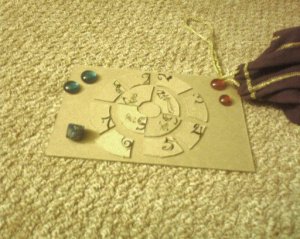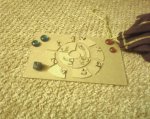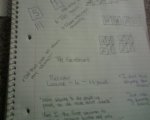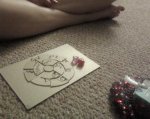be ashamed, young prince
When asked why I had supported Be Ashamed, Young Prince on the kickstarter questionnaire , I replied, because I wanted to support the creator of the game. I have a deep admiration of Nathan Paoletta’s game expertise and his incredible ability to articulate game design by breaking it down into it’s basic core components. (You can hear him on one of the more recent episodes of New Style).
His immense knowledge has provided an excellent foundation for Be Ashamed. It’s no surprise, after having read the game, that Paoletta has another well-written game (with evocative artwork done by Sarah Frary) to add to his repertoire. I had the pleasure of playing BAYP with two of my friends a few weeks ago and here’s my humble take on it.
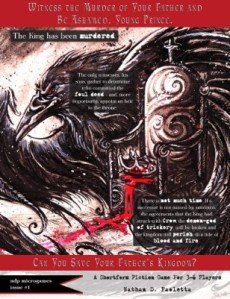
love
It’s short.
Can a creator make a cohesive game that is understandable to the audience in only a few short pages? Paoletta answers this question with a defiant, “Yes.” It’s a fascinating challenge he’s put towards the traditional hundred plus page rules manual. Contrary to it’s name Witness the Murder of your Father and Be Ashamed, Young Prince, is extremely short. The actual product is only (six) pages if you cut away the excess. Yup, you read right. (Six) pages.
Now, not only is the physical product short but so is the duration of time played. You must finish the game in one hour. (Check it. It’s in the rules) This is actually the main reason I was able to coax my buddies into playing. How many roleplaying games do you know that only take an hour to play? So many games take absurd amounts of time to prep: rules prep, player prep, character prep and by the time you’re finished, the character creation process has become a cumbersome session in and of itself. I was refreshed to learn that the rules compliment the sense of urgency established at the beginning of the game. Our group finished in roughly (fourty-five) minutes.
The physicality of the game
If you are completely unaware to the things I LOVE in roleplaying games, well Tangibility is my deal. Having physical objects that represent ideas or rules causes the game to be on a completely different level. Tangibility forces the characters to behave differently simply from the physical and visual feedback of having a token.
Because this token is considered currency in games, players will begin to act as if they have real money. Do I invest in this? Do I hold off and use it at a different juncture? It’s completely brilliant.
Paoletta has masterfully used this factor to his advantage. Be Ashamed is the type of game that is heavily based on the visual presentation of receiving and gifting stones. The stones represent the players physical trust or suspicion/direct challenge toward the storyteller. The more of a specific type of stone they have (red), the more likely a Prince will become a King, however the story might appear lackluster. The more of the other stone they have (black), the more interesting the story will become, but the less likely a Prince will become heir. As the players juggle with this inner conflict (invest or hold off?), their decisions are reinforced with the presence of the stones.
like
The story is concise with a interesting premise.
The King has perished and it’s up to the Princes to decide the new heir. If an heir isn’t crowned or the wrong heir crowned, the kingdom falls into utter chaos and bloodshed.
The agenda of each prince is intriguing. Become King. And if you can’t be King, pray you don’t back the wrong Prince. One Prince during the setup of the game has the chance to become the Ravensworn. This character is the betrayer, so to speak, of the kingdom and if he becomes King, he wins and well, everybody else loses. Big time.
It’s well structured
Through the duration of the game, you are required to do or say certain things at certain points.
Example: Player recites It is now [current time]. This matter must be resolved within the hour.
I have not played many games that are verbally structured as such and to be honest, it was really fun! This verbal structuring allowed us to understand the mood of the game. Not only that, but it served as a excellent prompt for the other players. Once a player was finished telling their side of the story, they would prompt the others verbally and then move to physically showing their support or challenge.
you should know
Storytelling is a must
Though we had a fun time, I want to stress to those of you interested in the game, you need to have a group of friends that enjoy spinning embellished tales of murder and betrayal.
This is definitely not your traditional roleplaying game, ladies. Instead, go ahead and file this under heavy storytelling. If you have a difficult time improving or have a bunch of friends who are shy, bashful, or find it difficult to come up with improvised stories, you might have a bit of a time with this one.
critique
Quick References for strong structure
Because the pacing of the game is very structured, I think a printable quick reference sheet might be helpful. Because I tend to get wrapped up in the storytelling aspect of the game, if there was a question brought up by another player or if it was time to move on to the next part of game, we would have to break character to find the answer. The feeling of the game is very fluid and having to break that makes the game feel choppy at points.
ultimately
This is an excellent game if you enjoy storygames, the creative process (there’s a short exert about him working with Sarah), or just like supporting creative endeavors.
The PDF is only (two), (TWO) dollars. While you can order the Magazine from MagCloud for (five).
I really love supporting artists and creators, but it’s even more fulfilling when you receive an excellent product in return.


